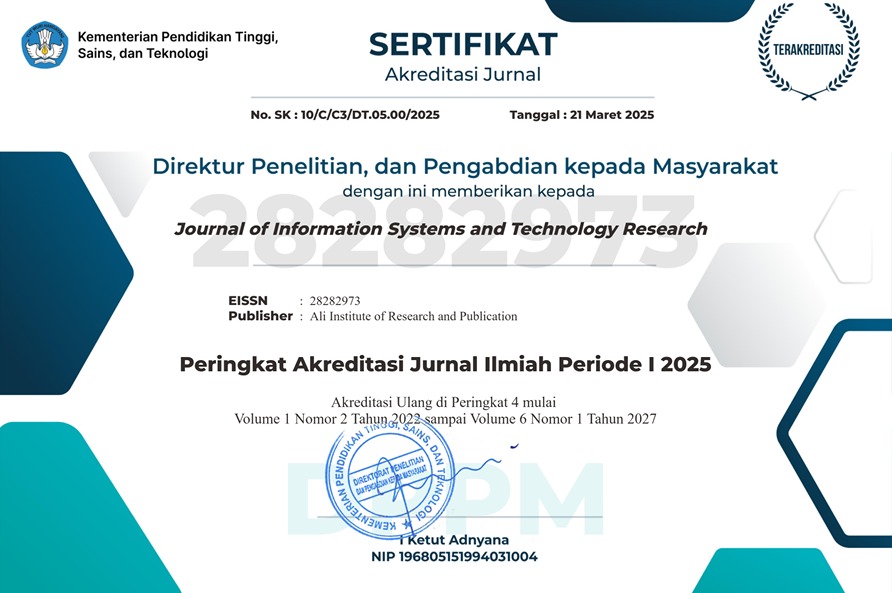Implementation Of Data Mining Grouping Of Old Age Guarantee (Jht) Based On Region In Pandemic Period
DOI:
https://doi.org/10.55537/jistr.v1i2.136Keywords:
Data Mining, Clustering , Old Age Security, RegionAbstract
During the COVID-19 pandemic, many companies experienced a decline or went bankrupt, so they had to reduce the number of workers and even close the company. BPJS Ketenagakerjaan is a public legal entity that is responsible to the president and functions to administer four programs, namely Work Accident Insurance (JKK), Death Insurance (JKM), Old Age Security (JHT), with the addition of the Pension Guarantee program ( JP). One of them is the submission of claims from too many participants of the Old Age Security program from various regions, especially the Langkat sub-district, so that it becomes a big problem to provide good service or information for the participants. For this reason, the author tries to create a system to support a computerized grouping process that can help automatically classify JHT claims by region, so there is an opportunity to design a grouping data mining system in it. Data mining is a process of mining data in very large amounts of data using statistical, mathematical methods, to utilize the latest artificial intelligence technology. Clustering is a method that is applied in creating a grouping data mining system to make it easier for employees to group JHT by region. Based on the analysis that has been done in the grouping of old-age insurance data using the clustering method, it is necessary to do the cluster process several times to get the same results according to the process that was first carried out, namely in cluster 1 : 2 3 2 cluster 2 : 2 8 2, cluster 3: 2 13 2 with 545 data in cluster 1, 308 data in cluster 2 and 421 data in cluster 3.
Downloads
References
J. Informasi, J. Wandana, and S. Defit, “Klasterisasi Data Rekam Medis Pasien Pengguna Layanan BPJS Kesehatan Menggunakan Metode K-Means,” vol. 2, pp. 4–9, 2020, doi: 10.37034/jidt.v2i4.73.
S. Rahayu, D. T. Nugrahadi, and F. Indriani, “CLUSTERING PENENTUAN POTENSI KEJAHATAN DAERAH DI KOTA BANJARBARU DENGAN METODE K-MEANS,” vol. 01, no. 01, pp. 33–45, 2014.
A. Ikhwan, “Analisis Cluster Jarak Antar Kecamatan Dengan Menggunakan Metode Euclidean Di Untuk Penetapan Zona Pengoperasian Mobil Mplik Di Kota Medan,” no. August, 2016.
A. Ikhwan and N. Aslami, “Implementasi Data Mining untuk Manajemen Bantuan Sosial Menggunakan Algoritma K-Means,” JurTI (Jurnal Teknol. Informasi), vol. 4, no. 2, 2020, [Online]. Available: http://jurnal.una.ac.id/index.php/jurti/article/view/2103.
R. Setiawan and N. Tes, “PENERAPAN DATA MINING MENGGUNAKAN ALGORITMA K-MEANS CLUSTERING UNTUK MENENTUKAN STRATEGI PROMOSI MAHASISWA BARU ( Studi Kasus : Politeknik LP3I Jakarta ),” vol. 3, no. 1, pp. 76–92, 2016.
A. Manaor and H. Pardede, “ANALISIS PENGELOMPOKKAN PERFORMANCE DOSEN DENGAN METODE,” no. January 2012, 2017.
G. Gustientiedina, M. H. Adiya, and Y. Desnelita, “Penerapan Algoritma K-Means Untuk Clustering Data Obat-Obatan,” J. Nas. Teknol. dan Sist. Inf., vol. 5, no. 1, pp. 17–24, 2019, doi: 10.25077/teknosi.v5i1.2019.17-24.
A. Almira, S. Suendri, and A. Ikhwan, “Implementasi Data Mining Menggunakan Algoritma Fp-Growth pada Analisis Pola Pencurian Daya Listrik,” J. Inform. …, vol. 6, no. 2, pp. 442–448, 2021, [Online]. Available: http://www.openjournal.unpam.ac.id/index.php/informatika/article/view/12278.
B. Kuniadi, D. Puspitaningrum, and F. Farady Coastera, “Perancangan Dan Pembuatan Aplikasi Steganografi Pesan Teks Pada Audio Digital Dengan Metode Least Significant Bit,” vol. 5, no. 3, pp. 285–297, 2017.
A. Ikhwan, “Penerapan Fuzzy Mamdani Untuk Sistem Pendukung Keputusan Pemilihan Laptop,” J. Fasilkom, vol. 9, no. 2, pp. 476–483, 2019, doi: 10.37859/jf.v9i2.1407.
E. Prasetyo, Data Mining Konsep dan Aplikasi Menggunakan Matlab. Yogyakarta: Andi, 2012.
M. Firdaoussi, H. Ghennioui, M. El Kamili, and M. Lamrini, “Performance evaluation of new blind OFDM signal recognition based on properties of the second-order statistics using universal software radio peripheral platform,” Indones. J. Electr. Eng. Comput. Sci., vol. 23, no. 2, pp. 1227–1236, 2021, doi: 10.11591/ijeecs.v23.i2.pp1227-1236.
Additional Files
Published
How to Cite
Issue
Section
License
Copyright (c) 2022 tatamustikadewi tata, Rusmin Saragih, Siswan Syahputra

This work is licensed under a Creative Commons Attribution-ShareAlike 4.0 International License.







